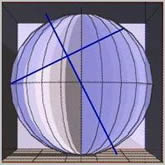Primes, Patterns, and Riemann
Primes, Patterns, and Riemann — Frequency Waves in Prime Distributions
Introduction
Prime numbers generate striking patterns when we visualise the multiples of each prime as "frequency
waves" or "vibrating strings".
Each prime p starts a wave of multiples with a fixed, unchanging interval of +2p:
General formula for the wave started by prime p:
n_k = p × (1 + 2k) (k = 0, 1, 2, ...)
Examples:
p = 3 → +6 (9, 15, 21, ...)
p = 5 → +10
p = 7 → +14
p = 11 → +22
p = 13 → +26
p = 17 → +34
p = 23 → +46
These waves are perfectly regular along the entire number line. When overlaid, they create zigzags,
pyramids, spirals, and tubular structures — revealing deep, non-random order in the distribution of
composites while primes remain as the untouched "gaps".
Early Frequency Waves
The waves begin at each prime and oscillate around a central "zero line"
Early frequency wave for prime 3 — regular +6 intervals forming a zigzag

Later frequency wave for prime 23 — showing larger, predictable +46 intervals
Pyramid Patterns
The #1 wave (all odd numbers: n = 2k + 1) overlays the others to form pyramid structures, with peaks at
perfect squares and predictable base ratios (e.g., 4-2-4 or 2-1-2).
Pyramid overlay on the #1 wave — peaks at squares, curving toward infinity
Sieve Interpretation
Overlaying all waves acts as an extended Sieve of Eratosthenes: composites are systematically marked
as multiples.
Sieve step for prime p: mark all m × p (m ≥ 2).
The remaining unmarked numbers are primes.
Sieve grid — waves canceling composites, primes emerging as gaps
3D Tubular Model
The flat waves twist into a three-dimensional tube spiraling from the central zero-point, resembling gun-
barrel rifling or expanding pond ripples. Precise least common multiple (LCM) calculations give measurable
lengths for repeating segments.
Example LCM for early primes (3,5,7): LCM (6,10,14) = 210 — the modular period.
Overlapping waves 7–17 aligned at the zero point
3D tubular model — waves spiraling outward from the origin

Riemann Connection
The waves oscillate around a common zero line. Where sections merge west of zero, triangular patterns
form with consistent angles. This visual harmony echoes the behaviour of Riemann zeta function zeros
on the critical line Re(s) = 1/2.
The explicit formula links primes to zeta zeros:
ψ(x) = x - ∑_{ρ} x^ρ/ρ - log(2π) - (1/2)log(1 - x^{-2})
(where ρ are non-trivial zeros).
Open Possibilities and Speculation
These unchanging, predictable frequency patterns invite further exploration:
- Longer alignments and their ties to pi digit biases.
- Symbolic echoes (e.g., lengths near 3168/888 and biblical gematria).
- Potential bridges to harmonic models in physics or consciousness.
All ideas remain speculative — awaiting deeper computation and verification.
The primes surprise with order hidden in the spaces between.
Page 2 The Six-Lane Highway
